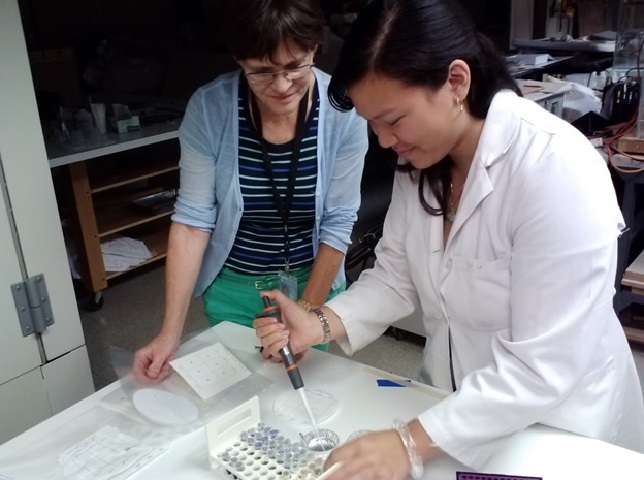Keeping Collections Bright

Hanna Szczepanowska (mentor) and Cyndi L. Trang stains Whatman 4 paper with sepia in solution.
This past summer, Cyndi Trang, an Oklahoma native who graduated magna cum laude and as an Honors program scholar from Marymount University in May 2013 got to put her newly acquired bachelors of science degree to good use. Cyndi was 1 of the 15 paid interns chosen for the 10 week internship at the Museum Conservation Institute (MCI) from June to August 2013. The MCI is a Smithsonian research facility located in Suitland, Maryland. The MCI scientists and conservators work mainly with the Smithsonian’s collections but the MCI has also collaborated with the FBI, U.S. Department of Homeland Security, and the United States Holocaust Memorial Museum to name a few.
During the intensive and exciting 10 weeks, Cyndi was involved in a research project to design a protocol to identify what solvents would dissolve sepia melanin. Melanin from fungi has been found to stain and affect the value of museum collections, thus it is essential to find a safe way to remove the stain without harm to the collection. Currently, there is no direct method to safely remove melanin stains. Hence, research is needed to identify how to safely remove melanin. Cyndi’s project begins the preliminary steps to help lay the foundation for the eventual removal process of melanin.
Her design protocol first involved identifying solvents to dissolve sepia melanin; however, this is a very difficult task because sepia melanin is very insoluble. The protocol created for this project also involved morphological analysis of surfaces of dry pigment and dissolved pigment. Analysis was performed on stains produced on Whatman 4 and Archers watercolor papers. Analytical instruments such as the scanning electron microscope (SEM), energy dispersive X-ray spectroscopy (EDS), Fourier transform infrared spectroscopy (FTIR), and densitometer were used: SEM-EDS to identify topography and characterize elemental analysis, FTIR to determine the absorption spectrum, and densitometer to measure optical density. The results from her study will be used for further studies later on. The accumulation of her summer research was presented at the Annual MCI Intern Conference.
When not mixing solutions and weighing sepia powder in the lab, Cyndi also attended weekly lectures, private tours, and conferences. She listened to lectures given by the MCI scientists on diverse topics ranging from stable isotopes to spectroscopic imaging of daguerreotypes. Cyndi also went on numerous intern tours where she saw three newly discovered unnamed fern species, a dolphin carcass awaiting cleaning in the necropsy lab, and the giant squid that also appeared in Dan Brown’s The Lost Symbol, to name a few. She was also one of the 100 attendees at the Annual Smithsonian Conservation Conference hosted by the MCI.
Cyndi’s long term goals are to become a physician and eventually teach. Cyndi says “the MCI internship was an amazing experience because it allowed me to immerse myself in interesting, cutting-edge research at one of the top conservation labs in the nation.” Furthermore, Cyndi states, “the experience and knowledge I gained from this Smithsonian research made my summer a blast!”






